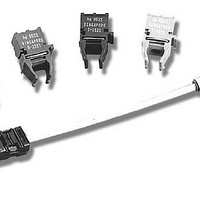HFBR-0559 Avago Technologies US Inc., HFBR-0559 Datasheet - Page 2

HFBR-0559
Manufacturer Part Number
HFBR-0559
Description
Fiber Optics, Evaluation Kit
Manufacturer
Avago Technologies US Inc.
Datasheet
1.HFBR-0559.pdf
(16 pages)
Specifications of HFBR-0559
Silicon Manufacturer
Avago
Silicon Core Number
HFBR-5903/5903E/5903A
Kit Application Type
Communication & Networking
Application Sub Type
Ethernet Transceiver
Main Purpose
Interface, Ethernet
Embedded
No
Utilized Ic / Part
HFBR-5903, FDDL, Fast Ethernet Transceivers
Primary Attributes
FDDE & Fast Ethernet SFF Transceiver Compatible
Secondary Attributes
SONET OC-3/SDH STM-1
Description/function
Fiber Optic Kit
Lead Free Status / RoHS Status
Lead free / RoHS Compliant
For Use With/related Products
HFCT-5903E
Lead Free Status / RoHS Status
Lead free / RoHS Compliant, Contains lead / RoHS non-compliant
The HFBR-5903 is also useful for both ATM 100 Mb/s
interfaces and Fast Ethernet 100 Base-FX interfaces. The
ATM Forum User-Network Interface (UNI) Standard,
Version 3.0, defines the Physical Layer for 100 Mb/s
Multimode Fiber Interface for ATM in Section 2.3 to be
the FDDI PMD Standard. Likewise, the Fast Ethernet
Alliance defines the Physical Layer for 100 Base-FX for
Fast Ethernet to be the FDDI PMD Standard.
ATM applications for physical layers other than 100 Mb/
s Multimode Fiber Interface are supported by Avago
Technologies. Products are available for both the single-
mode and the multimode fiber SONET OC-3c (STS-3c),
SDH (STM-1) ATM interfaces and the 155 Mb/s-194 logic
output and the Signal Detect function. The Data output
is differential. The Signal Detect output is single-ended.
Both Data and Signal Detect outputs are PECL compat-
ible, ECL referenced (shifted) to a +3.3 V power supply.
The receiver outputs, Data Out and Data Out Bar, are
squelched at Signal Detect Deassert. That is, when the
light input power decreases to a typical -38 dBm or
less, the Signal Detect Deasserts, i.e. the Signal Detect
output goes to a PECL low state. This forces the receiver
outputs, Data Out and Data Out Bar to go to steady
PECL levels High and Low respectively.
Package
The overall package concept for the Avago
Technologies transceiver consists of the following basic
elements; two optical subassemblies, an electrical
subassembly and the housing as illustrated in Figure 1.
Figure 1. Block Diagram.
DATA IN
DATA IN
2
DATA OUT
DATA OUT
SIGNAL
DETECT
QUANTIZER IC
LED DRIVER IC
R
T
X
X
SUPPLY
SUPPLY
R
T
X
X
GROUND
GROUND
The package outline drawing and pin out are shown in
Figures 2 and 3. The details of this package outline and
pin out are compliant with the multisource definition
of the 2 x 5 DIP. The low profile of the Avago
Technologies transceiver design complies with the
maximum height allowed for the MT-RJ connector over
the entire length of the package.
The optical subassemblies utilize a high-volume
assembly process together with low-cost lens elements
which result in a cost-effective building block.
The electrical subassembly consists of a high volume
multilayer printed circuit board on which the IC and
various surface-mounted passive circuit elements are
attached.
The receiver section includes an internal shield for the
electrical and optical subassemblies to ensure high
immunity to external EMI fields.
The outer housing is electrically conductive. The MT-RJ
port is molded of filled nonconductive plastic to
provide mechanical strength and electrical isolation.
The solder posts of the Avago Technologies design are
isolated from the internal circuit of the transceiver.
The transceiver is attached to a printed circuit board
with the ten signal pins and the two solder posts which
exit the bottom of the housing. The two solder posts
provide the primary mechanical strength to withstand
the loads imposed on the transceiver by mating with
the MT-RJ connectored fiber cables.
PIN PHOTODIODE
PRE-AMPLIFIER
SUBASSEMBLY
LED OPTICAL
SUBASSEMBLY
MT-RJ
RECEPTACLE
























